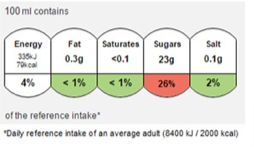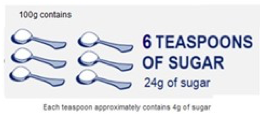A Label A Day Keeps The Doctor Away: Increasing Healthy Eating Via Innovative Packaging Information Labels
Relevant topics Archive, Conversion
You may sometimes purposely forgo reading the front-of-package (FOP) labels on the packaging of food goods. The main reason could be to ignore the unhealthiness of the chosen option and let your tastebuds revel in its sugary glory. Other reasons include the difficulty to read and the misleading nature of the labels, leaving the consumer in a state of confusion. If the label is hard to understand, you won’t want to read it and you won’t make a healthy decision.
In this paper, the researchers focus on sugar content and evaluate a novel FOP label’s effectiveness on participants’ preference for the healthier option when presented with various food choices. This was achieved by proposing categories in terms of their simplicity: simple options with few ingredients (smoothies), mid-complexity options with a shortlist of ingredients (yoghurts), and complex options with many ingredients (ready meals). Along with increasing complexity, the sugar content also increases; the smoothie has less sugar than the yoghurt, which has less sugar than the ready meal.
These food options were proposed with the traffic light system or the sugar-spoon label, representing the number of teaspoons of sugar contained in the product. By comparing a standard traffic-light label system versus their invented sugar-spoon label, the researchers found that the participants’ choices were healthier when the product presented was of simple composition (vs complex composition) and adopted their sugar-spoon label (vs the traffic light label).
The study concluded that the sugar-spoon label is more effective at favoring the choice of low-sugar content food goods than the regular traffic light label.
What cognitive process allows for this healthier decision? Find out below.
Some information is easier to interpret than others
On average, you make over 200 food decisions per day (Wansink & Sobal, 2007). These decisions are loaded with information to help you decide and (ideally) pick the healthy option. The information received can be there to motivate you to change unhealthy behavior. Such information may be through the labels on the packaging, the size of the portion, or size of the packaging itself.
The overload of information leads to a blockage of cognitive processing fluency. The notion of processing fluency is directly related to our varying degrees of effort and speed required to process information. When external information intake is rapid, completed with minimal effort, and results in spontaneous judgement, this suggests the information presented was easy to integrate.
Simpler products are defined as those with a small number of components. Previous research highlights the possibility that simpler products lead to greater processing fluency (Hermann et al., 2013), therefore, this should also hold true for simpler food products with a small number of ingredients compared to more complex ones with numerous ingredients. If there is a way to increase processing fluency, the consumer will have clear data with which to make an informed decision.
It is the increased processing fluency that led to increased uptake of the healthier food options in the study of this paper. The invented sugar-spoon label was easier to understand than the traffic light system because participants know what a teaspoon of sugar looks like and they were able to visualize the amount of sugar, leading to a better judgement by the participant.
Clearer information at shelf-height
As policymakers turn their attention to their population’s growing obesity, they are putting more effort into the communication of nutritional information available on food goods packaging. Contention exists on whether the mandated versions of FOP labels are effective at communicating to consumers the contents of the food product (Ikonen et al., 2020; Seiders & Petty, 2004). In fact, the policymakers have been unsuccessful: only 16.8% of European consumers rely on the information they can find in FOP labels when deciding on product choices (Grunert et al., 2010). Therefore, marketers and researchers have also applied their knowledge to find how to strike the balance between the quantity of information and understandability in a split second of reading.
Previous literature suggests that just showing FOP labels on packaging has a positive effect on consumers’ perceptions of a food’s healthiness (Ikonen et al, 2020; Newman et al., 2018). Simpler information cues lead to a reduced cognitive effort to be processed (Schwarz, 2004). This clearly signals a gap to be covered: labels are beneficial when they are truthful, simple, and guide the right behavior.


All FOP labels are not made equal
Alongside traffic light labels or other food labels, nutritional information presented in the form of a table, such as the Nutrition Facts Panel (NFP), is mandatory in most developed countries. However, just presenting the facts does not help influence the right behavior: you may find the table hard to understand and you may not know how to extract the information to guide your decision (Graham et al., 2012; Nikolova & Inman, 2015).
Consumers think the product with nutrition claims is healthier and are prepared to consume more of it faced with the same product lacking nutritional information; despite comparing two nutritionally identical products (Holtrop et al., 2019). This is where the implementation of smarter FOP labels, including symbols and rating systems, should take place.
However, novel labels like the sugar-spoon example should be avoided when used on packaging for a high-complexity food product. The results of the study show that when the yoghurts and ready meals presented a sugar-spoon label, they did not increase processing fluency and did not increase healthier product choice.
The most significant results were obtained when the food product was simple and the sugar label was, too: smoothies had the highest statistical support for these two conditions leading to healthier choices being made. This is the best situation in which to use the sugar-spoon label.
Take-home points
- Front of package (FOP) labels are universally beneficial: using a label, in general, to inform of food composition leads to increased healthier choices when compared to no label at all, especially for sugar.
- Simpler food alone leads to greater processing fluency.
- Simpler food is best linked with a high processing fluency FOP label.
- When a visual stimulus (spoons) is more relatable, it leads to more fluent processing than with the traffic light system. This leads to healthier choices being made.

